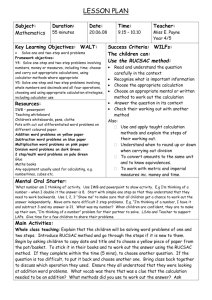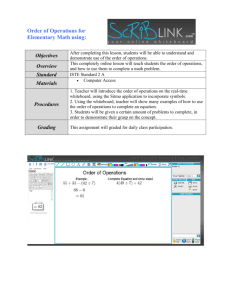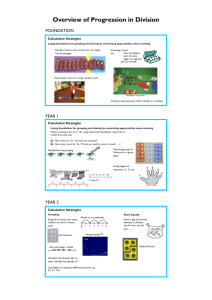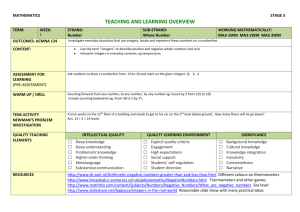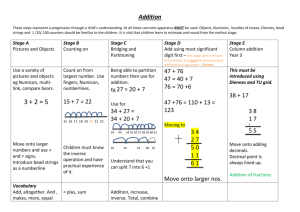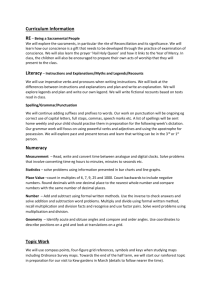Ranking Negative Numbers - Collaborative Learning Project
advertisement
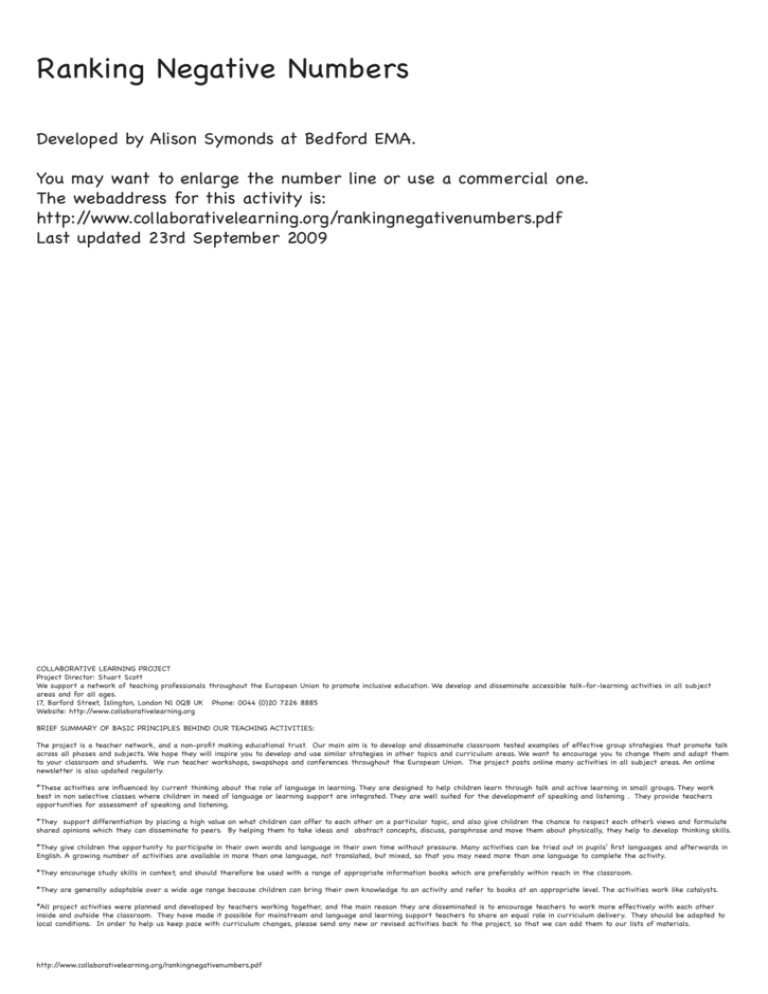
Ranking Negative Numbers Developed by Alison Symonds at Bedford EMA. You may want to enlarge the number line or use a commercial one. The webaddress for this activity is: http://www.collaborativelearning.org/rankingnegativenumbers.pdf Last updated 23rd September 2009 COLLABORATIVE LEARNING PROJECT Project Director: Stuart Scott We support a network of teaching professionals throughout the European Union to promote inclusive education. We develop and disseminate accessible talk-for-learning activities in all subject areas and for all ages. 17, Barford Street, Islington, London N1 0QB UK Phone: 0044 (0)20 7226 8885 Website: http://www.collaborativelearning.org BRIEF SUMMARY OF BASIC PRINCIPLES BEHIND OUR TEACHING ACTIVITIES: The project is a teacher network, and a non-profit making educational trust. Our main aim is to develop and disseminate classroom tested examples of effective group strategies that promote talk across all phases and subjects. We hope they will inspire you to develop and use similar strategies in other topics and curriculum areas. We want to encourage you to change them and adapt them to your classroom and students. We run teacher workshops, swapshops and conferences throughout the European Union. The project posts online many activities in all subject areas. An online newsletter is also updated regularly. *These activities are influenced by current thinking about the role of language in learning. They are designed to help children learn through talk and active learning in small groups. They work best in non selective classes where children in need of language or learning support are integrated. They are well suited for the development of speaking and listening . They provide teachers opportunities for assessment of speaking and listening. *They support differentiation by placing a high value on what children can offer to each other on a particular topic, and also give children the chance to respect each other’s views and formulate shared opinions which they can disseminate to peers. By helping them to take ideas and abstract concepts, discuss, paraphrase and move them about physically, they help to develop thinking skills. *They give children the opportunity to participate in their own words and language in their own time without pressure. Many activities can be tried out in pupils’ first languages and afterwards in English. A growing number of activities are available in more than one language, not translated, but mixed, so that you may need more than one language to complete the activity. *They encourage study skills in context, and should therefore be used with a range of appropriate information books which are preferably within reach in the classroom. *They are generally adaptable over a wide age range because children can bring their own knowledge to an activity and refer to books at an appropriate level. The activities work like catalysts. *All project activities were planned and developed by teachers working together, and the main reason they are disseminated is to encourage teachers to work more effectively with each other inside and outside the classroom. They have made it possible for mainstream and language and learning support teachers to share an equal role in curriculum delivery. They should be adapted to local conditions. In order to help us keep pace with curriculum changes, please send any new or revised activities back to the project, so that we can add them to our lists of materials. http://www.collaborativelearning.org/rankingnegativenumbers.pdf Ranking Negative Numbers Aims: o Practice adding and subtracting negative and positive numbers o Understand the values of positive and negative numbers o Use language of comparison and explanation (more then/less than...because...) o Work collaboratively Activity in pairs (after pairing activity) 1. Spread out the calculation cards on the desk 2. Take it in turns to choose a card and put it on the number line. 3. You must explain to your partner why it goes there. You might use words like “...because it’s less than...” or “...because it’s more than...” 4. If your partner disagrees you must listen and decide who is right. 5. When all the cards are on the line try writing your own calculations with a whiteboard pen in the right place. Explain activity. Ask pairs to explain to each other what they have to do. Ask a pupil to explain to the class what they have to do. Display this poster. Possible Introduction o Briefly define negative numbers using a numberline o Explain to your partner o Look at 3+-5= and 3- -5= illustrating on numberline; establish +- results in -, -- results in +. o Look at 3+5= and -3+-5= illustrating on numberline; establish negative add negative is always negative, positive add positive is always positive. o Look at -5+3= and -3+5= and 3-5= illustrating on numberline; establish that that it’s not so easy when there’s one of each. It depends on the value of the numbers. Assessment and Plenary o Draw numberline on the big board o Invite pairs to come and write a calculation onto it and say why it goes there o All can check and correct their results o Discuss what we have learnt http://www.collaborativelearning.org/rankingnegativenumbers.pdf Instructions Work in pairs 1. Spread out the calculation cards on the desk. You can decide whether to place them face up or face down! 2. Take it in turns to choose a card, and put it on the number line. 3. You must explain to your partner why it goes there. You might use words like “... because it’s less than...” or “...because it’s more than...” 4. If your partner disagrees you must listen and decide who is right. 5. When all the cards are on the line try writing your own calculations with a whiteboard pen in the right place on the number line. Instructions Work in pairs 1. Spread out the calculation cards on the desk. You can decide whether to place them face up or face down! 2. Take it in turns to choose a card, and put it on the number line. 3. You must explain to your partner why it goes there. You might use words like “... because it’s less than...” or “...because it’s more than...” 4. If your partner disagrees you must listen and decide who is right. 5. When all the cards are on the line try writing your own calculations with a whiteboard pen in the right place on the number line. http://www.collaborativelearning.org/rankingnegativenumbers.pdf 5+7 45+-37 -27+26 -20+-29 35-47 8--10 -6+15 -12--14 -30+5 9+11 17+-20 -5+42 -3+-5 23-10 21--2 -50+10 -7--17 20-20 33+19 8+-4 -9+14 -1+-5 6-15 16--8 http://www.collaborativelearning.org/rankingnegativenumbers.pdf positive numbers + 0 negative numbers http://www.collaborativelearning.org/rankingnegativenumbers.pdf -
